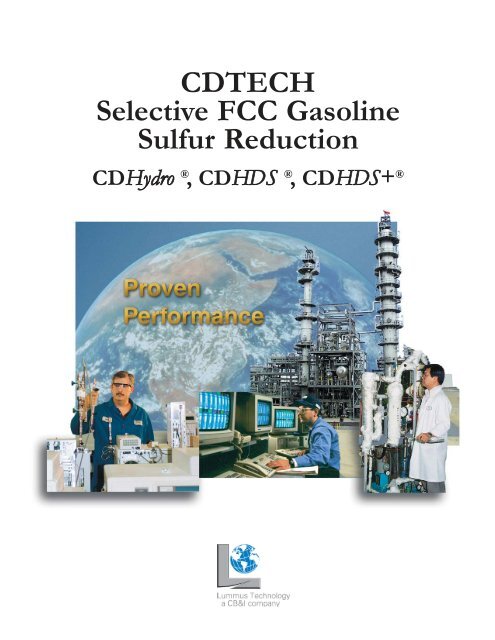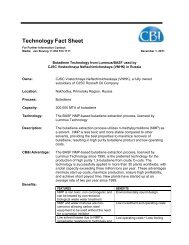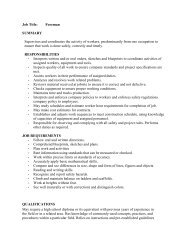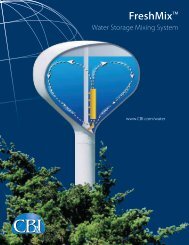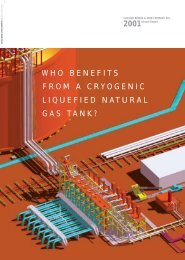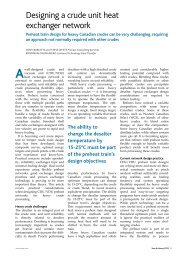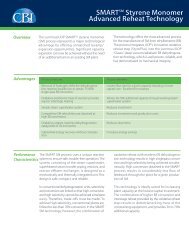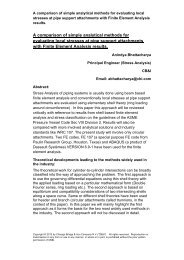CDTECH FCC English-10-8.qxd (Page 1) - CB&I
CDTECH FCC English-10-8.qxd (Page 1) - CB&I
CDTECH FCC English-10-8.qxd (Page 1) - CB&I
- No tags were found...
You also want an ePaper? Increase the reach of your titles
YUMPU automatically turns print PDFs into web optimized ePapers that Google loves.
<strong>CDTECH</strong><br />
Selective <strong>FCC</strong> Gasoline<br />
Sulfur Reduction<br />
CDHydro ® ,CDHDS ® ,CDHDS+ ®
Overview<br />
Full range catalytic naphtha (FRCN) is a<br />
major component of gasoline and is also<br />
the single largest contributor of sulfur to<br />
the gasoline pool. In order to meet<br />
increasingly strict government regulations,<br />
it is essential that refiners implement measures<br />
to reduce sulfur in FRCN.<br />
<strong>CDTECH</strong> ® (Catalytic Distillation<br />
Technologies) offers several commercially<br />
proven process technologies that selectively<br />
reduce sulfur in FRCN. The CDHydro ® ,<br />
CDHDS ® and CDHDS+ ® processes use<br />
the principle of catalytic distillation to<br />
reduce sulfur to as low as <strong>10</strong> ppm while<br />
retaining most of the octane value in<br />
FRCN without yield loss, allowing refiners<br />
to meet even the most severe gasoline sulfur<br />
regulations. Furthermore, since olefin<br />
saturation is minimal, hydrogen consumption<br />
is low, resulting in low operating costs.<br />
Key Process Advantages<br />
High conversion and low octane loss<br />
Commercial units using CDHydro,<br />
CDHDS and CDHDS+ processes have<br />
reduced the FRCN sulfur level by more<br />
than 99 percent. Total sulfur levels in the<br />
gasoline pool of <strong>10</strong> ppm and less are readily<br />
achievable and have been demonstrated.<br />
This is accomplished with less octane loss<br />
than other selective hydrodesulfurization<br />
(HDS) processes because with catalytic<br />
distillation, the desulfurization severity<br />
applied to the different fractions of the<br />
FRCN match the severity required for the<br />
particular sulfur species present in the<br />
respective fraction. This approach, in combination<br />
with the inherent reaction dynamics<br />
in a catalytic distillation column, suppresses<br />
olefin saturation. The actual octane<br />
loss will depend on the overall sulfur target<br />
in the gasoline pool and volume of other<br />
blending components; however, an FRCN<br />
(R+M)/2 octane loss of less than 1.5<br />
numbers is typical for a <strong>10</strong> ppm sulfur<br />
pool.<br />
Long catalyst life<br />
Catalyst life in commercial CDHydro,<br />
CDHDS and CDHDS+ process units<br />
exceeds <strong>FCC</strong> run-length. This ensures that<br />
catalyst replacement will only be required<br />
at scheduled <strong>FCC</strong> turnaround intervals.<br />
eliminating the need for catalyst regeneration<br />
equipment and temporary gasoline<br />
storage and pumping facilities.<br />
Conventional fixed-bed processes<br />
tend to lose significant catalyst activity<br />
over the run-length due to fouling of the<br />
catalyst, and normally require selective<br />
hydrogenation to remove diolefins prior to<br />
the HDS reactor. Even then, these<br />
processes cannot meet the <strong>FCC</strong> run-length<br />
without a shutdown to regenerate catalyst.<br />
A catalytic distillation column<br />
minimizes catalyst fouling – and hence<br />
deactivation – by continuously washing the<br />
catalyst with internal reflux and removing<br />
heavy precursors before they foul the catalyst.<br />
As a result, both the CDHydro and<br />
CDHDS processes maintain high catalyst<br />
activity and high selectivity throughout the<br />
ChevronTexaco CDHydro/CDHDS unit at Pembroke, UK<br />
<strong>FCC</strong> run-length. This means lower average<br />
octane loss over the full cycle compared to<br />
fixed-bed HDS processes.<br />
Flexibility to process feedstocks with a<br />
wide range of sulfur concentration<br />
A refinery’s economics depends on processing<br />
crudes from a variety of sources,<br />
which inevitably means a range of sulfur<br />
levels in the feedstock to the gasoline<br />
desulfurization unit. <strong>CDTECH</strong>’s catalytic<br />
distillation units are able to process feedstocks<br />
with high sulfur content and still<br />
achieve high sulfur conversion with low<br />
octane loss. The processing flexibility of<br />
the CDHydro and the CDHDS columns is<br />
a result of the ability to vary the desulfurization<br />
severity applied to different cuts of<br />
the gasoline by using handles such as operating<br />
pressure and cut points.<br />
Catalytic distillation environment<br />
The unique advantages of the catalytic distillation<br />
environment are:<br />
(a) Greater safety and stability (no danger<br />
of hot spots or runaway reactions as a<br />
Performance<br />
• Octane loss less than 1.5 (R+M)/2<br />
for <strong>10</strong> ppm sulfur pool<br />
• Demonstrated on full range naphtha<br />
– Not limited to gasoline with low<br />
olefins or low endpoint<br />
• Less than <strong>10</strong> ppm sulfur product<br />
– Achieve 99+% desulfurization<br />
• <strong>CDTECH</strong>’s commercial units on real<br />
feedstocks have met guarantees<br />
– Easier to operate than fixed bed<br />
reactors<br />
– No caustic treatment required for<br />
mercaptan control<br />
Flexibility<br />
• Handles feedstock swings<br />
• T 90<br />
control with no additional<br />
investiment<br />
• Investment can be staged as sulfur<br />
specifications get tighter<br />
Reliability<br />
• Guaranteed 5+ years catalyst life<br />
meets <strong>FCC</strong> cycle without:<br />
– Shutdowns for catalyst<br />
replacement<br />
– Spare equipment<br />
– Additional tankage<br />
– Selective hydrotreating<br />
– Extra run-off capacity<br />
• No catalyst disposal issues<br />
result of sudden changes in feedstock<br />
composition)<br />
(b) Long catalyst life because the catalyst<br />
is continuously washed by the liquid<br />
traffic in the column<br />
(c) Higher reliability since the catalyst is<br />
less susceptible to deactivation by fouling<br />
(wash effect) and to poisoning<br />
(counter-current effect)<br />
(d) The multi-phase environment allows a<br />
lower operating pressure (low hydrogen<br />
partial pressure), the use of low<br />
purity hydrogen, and operation without<br />
the large hydrogen recycles needed<br />
by fixed-bed processes to reduce fouling<br />
and to minimize mercaptan formation.<br />
The presence of olefins in the process
Irving Oil CDHydro/CDHDS unit located at St. John,<br />
New Brunswick, Canada<br />
combined with the H 2<br />
S produced during<br />
desulfurization can lead to recombination,<br />
forming heavy mercaptans. Catalytic distillation<br />
minimizes mercaptan formation by<br />
using distillation to position them in the<br />
catalyst zone where they decompose.<br />
Process Description<br />
Selective FRCN sulfur reduction begins<br />
with fractionation of the light naphtha<br />
overhead in a CDHydro column.<br />
Mercaptan sulfur reacts with diolefins to<br />
produce heavier sulfur compounds, and<br />
the remaining diolefins are partially saturated<br />
to olefins by reaction with hydrogen.<br />
Bottoms from the CDHydro column, containing<br />
the reacted mercaptans, are fed to<br />
the CDHDS column where mid and heavy<br />
cat naphtha are catalytically desulfurized in<br />
two separate reaction zones. HDS conditions<br />
are optimized for each fraction to<br />
achieve the desired sulfur reduction with<br />
minimal olefin saturation. The three desulfurized<br />
fractions can be made available as<br />
separate product streams for further processing<br />
or blending.<br />
These process technologies have been<br />
fully commercialized on challenging feeds<br />
having both high olefin and high sulfur<br />
content. Long term operation has demonstrated<br />
robust characteristics and long catalyst<br />
life, exceeding ten years continuous<br />
operation in CDHydro process units and<br />
five years in CDHDS process units.<br />
Optionally, a second stage of desulfurization<br />
improves performance with even<br />
higher octane retention while achieving<br />
very low sulfur content. This version, the<br />
CDHDS+ process, also maintains high<br />
HDS performance during refinery upsets.<br />
No cracking reactions occur in the<br />
process, so yield losses are essentially eliminated<br />
with vent gas recovery. The product<br />
streams are stabilized as appropriate for<br />
the individual refinery. The two columns<br />
are heat integrated to minimize energy<br />
requirements and the configuration is customized<br />
for site-specific availability of utilities<br />
and energy conservation objectives.<br />
Hydrogen is typically utilized on a<br />
once-through basis in the CDHydro column.<br />
It is usually supplied to the CDHDS<br />
column at typical reformer hydrogen pressure<br />
levels, without additional compression.<br />
Optimal integration with hydrogen<br />
generation and sour gas treating facilities<br />
at most sites will include hydrogen recycle<br />
and CDHDS vent gas treating within the<br />
process.<br />
In the CDHDS process, the recombination<br />
of olefins and hydrogen sulfide to<br />
form mercaptans is limited. Since there is<br />
no need to over-saturate olefins in order to<br />
achieve ultra-low sulfur levels, octane loss<br />
is minimal.<br />
Commercial Experience<br />
Over one million barrels per standard day<br />
(BPSD) of gasoline is treated using the<br />
CDHydro, CDHDS and CDHDS+<br />
processes. These technologies have been<br />
selected by leading refining companies –<br />
Chevron, Shell, Motiva, Valero, Agip ENI,<br />
Irving Oil, Hellenic, and PetroChina – for<br />
multiple site applications. The <strong>CDTECH</strong><br />
process technologies are working in large<br />
units and small units, with high feed sulfur<br />
and low feed sulfur, all meeting or besting<br />
the target product sulfur level and with<br />
low octane loss.<br />
Summary<br />
The combination of the CDHydro,<br />
CDHDS and CDHDS+ processes gives<br />
refiners low capital and operating cost<br />
solutions for gasoline sulfur reduction. In<br />
addition, low hydrogen consumption, high<br />
octane retention, and long catalyst life<br />
minimize changes required in other refinery<br />
processes.<br />
These processes are members of a<br />
family of technologies developed and<br />
commercialized by <strong>CDTECH</strong> for use in<br />
the petroleum refining and petrochemical<br />
industries. <strong>CDTECH</strong> is a partnership<br />
between Lummus Technology, a CB&I<br />
company, and Chemical Research and<br />
Licensing, a CRI company.<br />
<strong>FCC</strong> Gasoline Desulfurization via Catalytic Distillation<br />
CDHydro<br />
CDHDS<br />
CW<br />
Off Gas<br />
CW<br />
Off Gas<br />
Hydrogen<br />
Treated<br />
<strong>FCC</strong> LCN<br />
<strong>FCC</strong> C5+<br />
Gasoline<br />
Partial<br />
Dehexanizer<br />
MP Steam<br />
Hydrogen<br />
<strong>FCC</strong> MCN / HCN<br />
HCN<br />
MCN<br />
Desulfurized<br />
<strong>FCC</strong> C5+ Gasoline
CDHydro ®<br />
Selective hydrogenation using catalytic distillation:<br />
n MAPD reduction in mixed C 3s<br />
n C 4 diolefins reduction in mixed C 4s<br />
(hydroisomerization option)<br />
n C 4 acetylenes reduction in mixed C 4s<br />
n C 5 diolefins reduction in mixed C 5s<br />
(hydroisomerization option)<br />
n C 6 diolefins reduction in mixed C 6s<br />
(hydroisomerization option)<br />
n Benzene reduction in LSR and reformate streams<br />
n Mercaptan reduction in C 4/C 5/C 6 olefinic streams<br />
n Hydrogenation of DIB to IsoOctane<br />
n Hydrogenation of benzene to high purity cyclohexane<br />
CDHDS ® and Desulfurization using catalytic distillation:<br />
CDHDS+ ® n <strong>FCC</strong> gasoline<br />
n Jet fuel/kerosene<br />
ISOMPLUS ®<br />
Dimer 8<br />
®<br />
CDAlky ®<br />
CDCumene ®<br />
CDIB ®<br />
CDAcrylamide ®<br />
<strong>CDTECH</strong> EB ®<br />
BASF SELOP<br />
Sulzer Butene-1<br />
CDMtbe ®<br />
CDEtbe ®<br />
CDTame ®<br />
CDTaee ®<br />
CDEthers ®<br />
methanol<br />
CDEtherol ®<br />
Process Technologies from <strong>CDTECH</strong><br />
Isomerization of n-olefins to iso-olefins<br />
Dimerization of iso-olefins in C 4 streams*<br />
Alkylation of C4 olefins with isobutane<br />
Alkylation of benzene with propylene<br />
Decomposition of MTBE to high-purity isobutylene<br />
Hydration of acrylonitrile to acrylamide<br />
Alkylation of benzene with ethylene<br />
Selective hydrogenation of C 4s and C5s for diolefin reduction<br />
Superfractionation of mixed C 4s to produce high-purity<br />
butene-1<br />
MTBE production from mixed C 4s and methanol<br />
ETBE production from mixed C 4s and ethanol<br />
TAME production from mixed C5s and methanol<br />
TAEE production from mixed C 5s and ethanol<br />
Coproduction of MTBE and TAME from mixed C4/C5s and<br />
Selective hydrogenation of diolefins combined within ether<br />
processes above<br />
* offered jointly with Snamprogetti<br />
<strong>10</strong>/08


